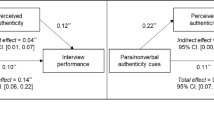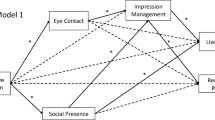Abstract
Behavior description interviews (Janz, 1982) were compared to standard interview techniques in the context of a recruiting interview. Positive or negative recruiter affect was combined with the two types of interview techniques to determine if positive recruiter affect can reduce the hypothesized stress induced by behavior description interviews. Simulated recruiting interviews were presented using videotaped interviews where different types of questions were asked (behavior description vs. standard) and recruiter affect was manipulated through eye contact, smiling, and other non-verbal communication. Sixty-seven undergraduates were randomly assigned to view one of the four simulated interviews. Subjects' perceptions of the recruiter and interview were collected on a post-experimental questionnaire. Multivariate analysis of variance indicated main effects for both type of interview questions (F=2.69, p<.05) and recruiter affect (F=9.25, p<.001). Implications for recruiting interviews were discussed.
Similar content being viewed by others
References
Dunnette, M. D., & Borman, W. C. (1979). Personnel selection and classification systems.Annual Review of Psychology, 30, 477–525.
Gilmore, D. C., Beehr, T. A., & Love, K. G. (1986). Effects of applicant sex, applicant physical attractiveness, type of rater, and type of job on interview decisions.Journal of Occupational Psychology, 59, 103–109.
Gilmore, D. C., & Ferris, G. R. (1980). Problems in the employment interview. In K. M. Rowland, M. London, G. R. Ferris, J. L. Sherman (Eds.),Current Issues in Personnel Management. Boston: Allyn & Bacon.
Gilmore, D. C., & Ferris, G. R. (1983). The recruitment interview. In K. M. Rowland, G. R. Ferris, J. L. Sherman (Eds.)Current Issues in Personnel Management. Boston: Allyn & Bacon.
Hakel, M. D. (1981). Employment Interview. In K. M. Rowland & G. R. Ferris (Eds.),Personnel Management. Boston: Allyn & Bacon.
Hays, W. L. (1963).Statistics. New York: Holt, Rinehart, & Winston.
Imada, A. S., & Hakel, M. D. (1977). Influence of nonverbal communication and rater proximity on impressions and decisions in simulated employment interviews.Journal of Applied Psychology, 62, 295–300.
Janz, T. (1982). Initial comparisons of patterned behavior description interviews versus unstructured interviews.Journal of Applied Psychology, 67, 577–580.
Janz, T., Hellervik, L., & Gilmore, D. C. (1986).Behavior description interviewing: New, accurate, cost effective. Boston: Allyn & Bacon.
Latham, G. P., Saari, L. M., Pursell, E. D., & Campion, M. A. (1980). The situational interview.Journal of Applied Psychology, 65, 422–427.
Mayfield, E. C., Brown, S. H., & Hamstra, B. W. (1980). Selection interviewing in the life insurance industry: An update of research and practice.Personnel Psychology, 33, 725–739.
Rogers, D., & Sincoff, M. (1978). Favorable impression characteristics of the recruitment interview.Personnel Psychology, 31, 495–504.
Rosenbaum, B. L. (1973). Attitudes toward invasion of privacy in the personnel selection process and job applicant demographic and personality correlates.Journal of Applied Psychology, 58, 333–338.
Rynes, S. L., Heneman, H. G., & Schwab, D. P. (1980). Individual reactions to organizational recruiting: A review.Personnel Psychology, 33, 529–542.
Rynes, S. L., & Miller, H. E. (1983). Recruiter and job influences on candidates for employment.Journal of Applied Psychology, 68, 147–154.
Schmitt, N. (1976). Social and situational determinants of interview decisions: Implications for the employment interview.Personnel Psychology, 29, 70–101.
Author information
Authors and Affiliations
Additional information
The author would like to thank Michael O'Connor, Liebe Clayton, Michael Moody, and Patrick Gann for their assistance in the conduct of this research.
This work was supported in part by funds from the Foundation of the University of North Carolina at Charlotte and from the State of North Carolina.
Rights and permissions
About this article
Cite this article
Gilmore, D.C. Applicant perceptions of simulated behavior description interviews. J Bus Psychol 3, 279–288 (1989). https://doi.org/10.1007/BF01023046
Issue Date:
DOI: https://doi.org/10.1007/BF01023046




